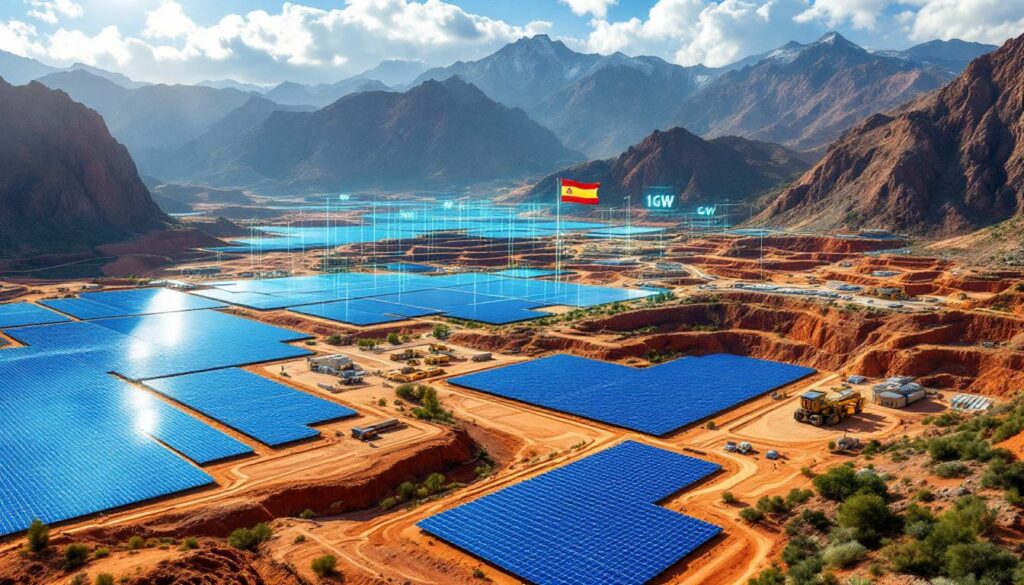What Makes Peru Attractive for Spanish Mining Investments?
Peru has emerged as a prime destination for Spanish investments in the mining sector, particularly in renewable energy infrastructure. The country's rich mineral resources, established mining operations, and growing demand for sustainable energy create a compelling investment landscape for companies like Zelestra.
Peru's Position in the Global Copper Market
Peru maintains its status as the world's third-largest copper producer, making it a strategic player in global supply chains for critical minerals. The country's southern regions host numerous major mining operations that form the backbone of its mineral economy.
The established mining infrastructure and technical expertise in Peru provide a solid foundation for foreign investments. With decades of mining industry evolution, Peru offers a mature industry environment with experienced labor forces and supply chains already in place.
According to industry data, Peru produced approximately 2.4 million metric tons of copper in 2024, representing about 11% of global copper supply forecast. This significant output positions Peru as an essential supplier for industries ranging from electronics to renewable energy technologies.
Current Energy Landscape in Peruvian Mining
The Peruvian energy sector currently relies heavily on hydroelectric power, which accounts for approximately 45% of the country's energy production. This dependence on hydro resources creates both opportunities and challenges for mining operations.
A growing concern in Peru's energy sector is the increasing business concentration in power distribution. Chinese companies have gained significant control over the country's power infrastructure in recent years. According to industry reports, China Southern Power Grid International now controls just over half of Lima's power distribution, while China Three Gorges Corporation covers the other half and manages Peru's third-largest power generator.
Mining companies operating in Peru face mounting pressure to adopt sustainable energy solutions. As global markets increasingly demand responsibly sourced minerals with lower carbon footprints, the need for electrification and decarbonisation has become both an environmental and business imperative.
What Is Zelestra's $1 Billion Investment Strategy in Peru?
Zelestra, a Spanish renewable energy company owned by Swedish firm EQT, has unveiled an ambitious plan to power Peru's mining sector through substantial investments in clean energy infrastructure. This strategy represents one of the most significant foreign investments in Peru's energy sector in recent years.
Zelestra's Renewable Energy Expansion Plans
Zelestra has committed to investing a minimum of $1 billion over the next five years in Peru, with potential to reach $1.5 billion depending on project development and market conditions. This substantial financial commitment signals long-term confidence in Peru's mining and energy sectors.
The company aims to develop 1 gigawatt (GW) of renewable energy production capacity specifically in Peru, focusing primarily on powering mining operations in the copper-rich southern regions. This targeted approach ensures the energy produced will serve the country's most energy-intensive industry.
As stated by Zelestra's CEO Jose Luis Garcia, "I'm convinced that most, if not all, of the energy projects we build in Peru will be used to supply mining companies." This declaration highlights the company's strategic focus on serving the mining sector's growing energy needs.
This investment in Peru forms part of Zelestra's broader regional strategy to develop 3 GW of renewable energy capacity across Latin America within the next five years. The geographic distribution of this capacity is planned as 50% in Chile, 30% in Peru, and the remainder in Colombia, creating a diversified regional portfolio.
Key Projects in Development
The flagship project in Zelestra's Peruvian portfolio is the San Martin solar park in Arequipa, representing a $177 million investment. Recently inaugurated in July 2025, this facility stands as the largest solar plant in Peru with 300 megawatts capacity. The plant's strategic location in the southern region positions it to serve several major mining operations.
"The San Martin solar park represents a milestone in Peru's energy transition, demonstrating that large-scale renewable energy can reliably serve the mining sector's intensive power needs," noted Garcia during the facility's inauguration.
Another significant development is the Babilonia solar plant, also in Arequipa, with a planned investment of $140 million. This facility will have a capacity of 238 megawatts and is currently in the development phase. Construction is expected to begin in late 2025, with operations commencing by mid-2026.
Zelestra has also announced plans for three additional renewable energy projects in southern Peru, with a combined capacity of approximately 450 megawatts. These projects are in various stages of planning and development, with specific details regarding locations and timelines to be released in the coming months.
The company has secured agreements with transmission companies like Kallpa Energy to ensure effective delivery of the generated power to mining clients. These partnerships address one of the key challenges in renewable energy development – connecting generation facilities to end users through reliable transmission infrastructure.
Who Are the Major Mining Companies That Could Benefit?
Several major mining operators in Peru stand to gain from Zelestra's renewable energy investments. The strategic positioning of these projects in copper-rich southern regions aligns perfectly with the locations of many of Peru's most significant mining operations.
Potential Mining Partners in Peru
Freeport-McMoRan, which operates Cerro Verde – Peru's largest copper mine – is positioned as a prime potential beneficiary. Located in Arequipa, Cerro Verde's proximity to Zelestra's solar projects makes it a natural partner for renewable energy supply agreements.
MMG Ltd, with its significant copper operations in southern Peru, represents another potential major client. The company's Las Bambas mine, one of Peru's largest copper producers, has substantial energy requirements that could be partially met through renewable sources.
Other major mining companies with established operations in Peru that could benefit include Glencore, which operates several mines throughout the country, and Anglo American, which has a significant presence in Peru's mining sector. The Mexico Group, with various mining interests in the country, is also among potential beneficiaries.
These companies collectively represent a substantial portion of Peru's mining output and energy consumption, making them attractive potential clients for Zelestra's renewable power generation.
Strategic Advantages for Mining Companies
A key factor driving potential partnerships is the timing of energy contract renewals. According to Zelestra's CEO, many mining companies have long-term energy contracts coming up for renewal in the next three years. This creates a perfect opportunity for these operations to transition to renewable energy sources.
For mining companies, adopting renewable energy offers multiple strategic advantages:
- Cost stability: Long-term fixed-price renewable energy contracts can provide protection against fossil fuel price volatility
- Sustainability credentials: Reduced carbon footprint improves ESG (Environmental, Social, Governance) performance
- Social license to operate: Communities increasingly expect mining operations to minimize environmental impacts
- Market access: Buyers of metals increasingly demand responsibly sourced materials with lower carbon footprints
- Regulatory compliance: Anticipating stricter carbon regulations in global markets
The combination of these factors creates a compelling business case for mining companies to partner with renewable energy providers like Zelestra.
What Makes This Investment Significant for Peru's Mining Future?
Zelestra's substantial investment in renewable energy infrastructure represents more than just additional power capacity for Peru – it signals a potential transformation in how the country's mining sector operates and competes globally.
Economic and Environmental Implications
This investment contributes significantly to the diversification of Peru's energy matrix beyond its traditional reliance on hydroelectric power. While hydro has provided relatively clean energy, its vulnerability to seasonal variations and climate change makes diversification prudent for energy security.
The reduced carbon footprint for mining operations powered by renewables enhances Peru's competitiveness in global markets increasingly concerned with the environmental impact of resource extraction. As major buyers implement carbon border adjustment mechanisms and procurement policies favoring low-carbon materials, Peruvian mines powered by renewables will be better positioned.
From an economic perspective, renewable energy offers the potential for reduced operational costs in the long term. While initial capital expenditures are significant, the near-zero marginal cost of solar power generation means that operating expenses are highly predictable and generally lower than fossil fuel alternatives over the project lifetime.
Additionally, these projects create substantial employment opportunities, with each major solar facility requiring hundreds of workers during construction and dozens for ongoing operations and maintenance. This contributes to economic development in the regions hosting these facilities.
Transmission and Distribution Partnerships
A critical aspect of Zelestra's strategy involves agreements with companies like Kallpa Energy for the transmission and distribution of the generated power. These partnerships ensure that the renewable energy produced can reliably reach mining operations across southern Peru.
The development of transmission infrastructure to deliver energy to mining clients represents a significant value-add beyond mere power generation. By investing in the full energy delivery chain, Zelestra is helping to build a more resilient energy ecosystem for Peru's mining operations.
Integration with existing power networks presents both challenges and opportunities. While connecting to established grids can be complex, it also creates possibilities for enhanced grid stability and reliability when properly managed with modern control systems and energy storage technologies.
How Does This Fit Into Zelestra's Regional Strategy?
Zelestra's investments in Peru represent just one component of a comprehensive regional approach to renewable energy development across Latin America. This broader strategy positions the company to capitalize on similar opportunities throughout the region's resource-rich countries.
Zelestra's Latin American Renewable Energy Portfolio
The company has set an ambitious target of developing 3 GW of total generation capacity across Latin America within five years. This capacity will be distributed with approximately 50% in Chile, 30% in Peru, and the remainder in Colombia, creating a diversified portfolio across three of the region's most significant mining economies.
This geographic distribution reflects a strategic focus on countries with both substantial mining activity and favorable conditions for renewable energy development. Chile's Atacama Desert offers some of the world's highest solar radiation levels, while Peru and Colombia provide complementary opportunities with different resource profiles and market dynamics.
Zelestra's technology mix includes primarily solar installations, but also encompasses hybrid systems and battery-powered solutions to ensure reliable power supply even when the sun isn't shining. This technological diversification enhances the reliability of renewable energy for industrial clients with 24/7 operational requirements.
By focusing on mining-heavy economies, Zelestra has positioned itself to serve an industry with both substantial energy needs and increasing pressure to reduce its environmental footprint. This specialized focus differentiates the company from more general renewable energy developers.
Corporate Background and Financial Support
Zelestra's financial stability is underpinned by its ownership structure – the company is owned by Swedish firm EQT, a global investment organization with over €73 billion in assets under management. This strong financial backing provides the resources necessary for large-scale infrastructure development.
The company has reported strong lender interest in financing its renewable projects, reflecting the growing appetite among financial institutions for sustainable energy investments. This favorable financing environment helps Zelestra accelerate project development while optimizing capital costs.
Zelestra brings substantial experience in developing large-scale energy infrastructure, having successfully completed similar projects in other markets. This track record enhances the company's credibility with both mining clients and financial partners.
The company's strategic focus on industrial clients, particularly mining companies, allows it to develop specialized expertise in meeting the unique energy requirements of resource extraction operations. This industry-specific knowledge creates competitive advantages in project design, implementation, and operation.
What Challenges Could Impact Spanish Renewable Investments in Peru?
Despite the promising outlook, Zelestra's ambitious investment plans face several potential obstacles that could affect project timelines, financial returns, and overall success in the Peruvian market.
Regulatory and Political Considerations
Peru's changing political landscape presents both opportunities and risks for foreign investors. The country has experienced political instability in recent years, with multiple changes in leadership creating uncertainty around policy continuity and regulatory frameworks.
The regulatory environment for renewable energy projects in Peru continues to evolve. While the government has generally supported clean energy development, the specific mechanisms, incentives, and approval processes can be complex and subject to change with new administrations.
Competition with established energy providers, particularly those with strong government connections, may create challenges for new entrants like Zelestra. The significant Chinese presence in Peru's energy sector, including control over major distribution networks, adds another competitive dimension.
Permitting and approval processes for large-scale energy projects can be time-consuming and unpredictable. Environmental impact assessments, local consultations, and various regulatory clearances must be navigated successfully before construction can begin, potentially affecting project timelines.
Market and Operational Risks
Integration with existing mining operations presents technical challenges. Mining facilities typically require highly reliable power with specific voltage and frequency characteristics. Ensuring that variable renewable generation can meet these stringent requirements necessitates careful system design and potentially additional investment in power conditioning equipment.
The weather-dependent nature of solar generation creates reliability considerations. While southern Peru offers excellent solar resources, seasonal variations and weather events can affect output. Addressing these variations through energy storage, hybrid systems, or backup arrangements adds complexity and cost.
Construction and development timelines face potential delays due to supply chain constraints, skilled labor availability, and logistical challenges associated with building large-scale infrastructure in sometimes remote locations. These factors could affect project economics and the timing of revenue generation.
Local opposition or environmental concerns may emerge despite the generally positive environmental profile of renewable energy. Issues such as land use, visual impact, water consumption for panel cleaning, and effects on local ecosystems must be addressed through thoughtful project design and community engagement.
FAQ About Spanish Investments in Peruvian Mining Energy
Why are Spanish companies investing in Peru's mining sector?
Spanish renewable energy companies like Zelestra see significant opportunities in Peru's mining sector due to several converging factors. Peru's position as the world's third-largest copper producer creates substantial energy demand from mining operations. The country's established mining infrastructure provides a ready market for power generation.
Additionally, the growing global emphasis on sustainable resource extraction has created incentives for mining companies to source cleaner energy. Spanish firms bring extensive experience in renewable energy development from both domestic and international projects, positioning them well to address this market need.
The timing is particularly favorable as many mining operations have long-term energy contracts coming up for renewal in the next three years, creating a natural opportunity to transition to renewable sources.
How will renewable energy benefit mining companies in Peru?
Renewable energy offers multiple advantages to mining companies operating in Peru:
- Cost predictability: Long-term power purchase agreements with renewable generators provide stable energy costs, protecting operations from fuel price volatility
- Carbon footprint reduction: Replacing fossil fuel-based electricity with renewables significantly reduces Scope 2 emissions
- ESG credential enhancement: Improved environmental performance strengthens social license to operate and access to capital
- Marketing advantage: Metals produced with renewable energy may command premium prices from buyers with carbon reduction targets
- Regulatory compliance: Anticipates increasingly stringent carbon regulations in export markets
For remote operations, on-site renewable generation can also enhance energy security by reducing dependence on potentially vulnerable transmission infrastructure.
What types of renewable energy projects are being developed?
The current focus of Spanish investments in Peru is primarily on large-scale solar projects. The flagship development is the San Martin solar park (300 MW), which is now the largest solar facility in Peru. Another major project in development is the Babilonia solar plant (238 MW).
These utility-scale solar installations are strategically located in southern Peru, particularly in the Arequipa region, where solar resources are abundant and major mining operations are concentrated. The projects typically include advanced tracking systems that allow solar panels to follow the sun's path, maximizing energy production.
Future developments may expand to include hybrid systems combining solar with battery storage solutions to ensure reliable power supply during nighttime hours or periods of low solar production. Energy storage technologies are becoming increasingly important components of renewable energy systems serving industrial clients with 24/7 operational requirements.
How does this investment compare to Chinese involvement in Peru's energy sector?
Spanish and Chinese investments in Peru's energy sector follow notably different strategies. Chinese companies have focused primarily on acquiring existing power infrastructure. China Southern Power Grid International now controls over half of Lima's power distribution, while China Three Gorges Corporation covers the other half and manages Peru's third-largest power generator.
In contrast, Spanish investments led by companies like Zelestra are centered on developing new renewable energy generation capacity. This approach focuses on creating additional clean energy resources rather than controlling existing infrastructure.
The different approaches reflect distinct investment philosophies. Chinese firms have typically pursued control of strategic assets and distribution networks, while Spanish investments focus on developing new generation capacity that aligns with global sustainability trends.
Both approaches will shape Peru's energy future, but they represent complementary rather than directly competing strategies within the sector.
Future Outlook for Spanish-Peruvian Mining Partnerships
The trajectory of Spanish investments in Peru's mining energy sector points toward deepening relationships and expanding opportunities. As initial projects prove successful, the foundation for longer-term collaboration between Spanish energy developers and Peruvian mining operations continues to strengthen.
Emerging Trends and Opportunities
The growing global demand for responsibly sourced minerals creates a favorable environment for continued investment in clean energy for mining operations. As manufacturers of electric vehicles, renewable energy equipment, and electronics face pressure to reduce embodied carbon in their supply chains, minerals produced with renewable energy will likely command premium prices.
Mining companies face increasing pressure to reduce their carbon footprints from multiple stakeholders, including investors, customers, regulators, and communities. This creates strong incentives to partner with renewable energy providers capable of delivering reliable, cost-effective clean power.
The partnership between Spanish energy expertise and Peruvian mining operations creates opportunities for technology transfer and knowledge sharing. Advanced energy management systems, microgrid technologies, and integration of renewables with existing power systems represent areas where Spanish firms can contribute valuable expertise.
The development of green mining practices and certifications is gaining momentum globally. Energy sourcing forms a critical component of these standards, creating additional motivation for mining companies to secure renewable power supplies that can help them achieve certification and market access.
Long-term Investment Potential
As initial projects demonstrate technical and financial viability, expansion beyond these developments becomes increasingly likely. Successful track records in Peru will build confidence among both mining clients and financial backers to support additional renewable energy capacity.
Want to Invest in the Next Major Mineral Discovery?
Discovery Alert instantly notifies investors of significant ASX mineral discoveries through its proprietary Discovery IQ model, transforming complex mineral data into actionable insights. Understand why historic discoveries can generate substantial returns by visiting Discovery Alert's dedicated discoveries page and begin your 30-day free trial today to position yourself ahead of the market.




